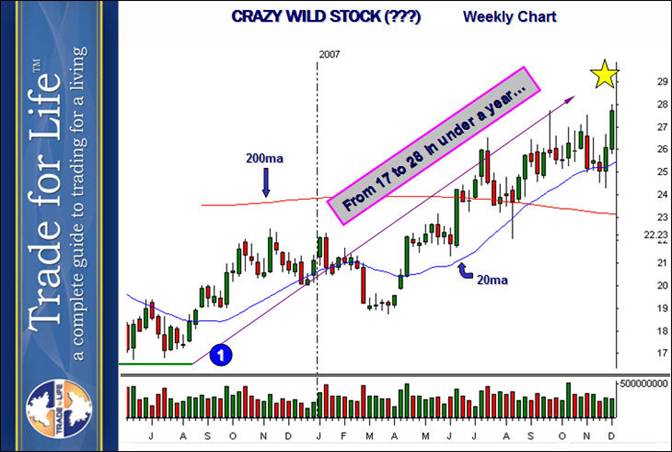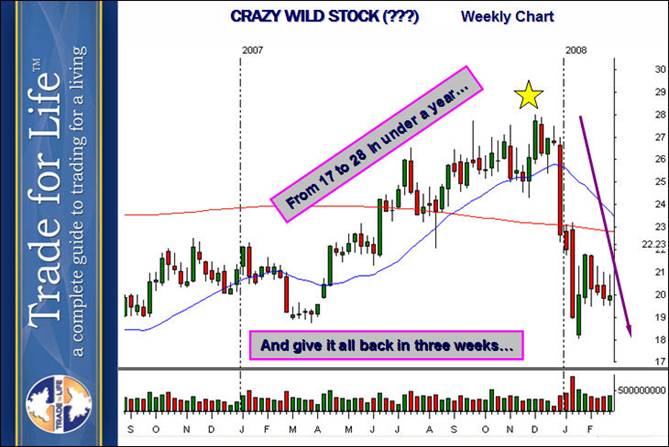
VCM Weekly Trading Lessons
Are You Still Investing?
Are you still investing? Shouldn’t you be? Well, it may just be our choice of words but we believe the term ‘investing’ is no longer a valid term. Now, don’t get us wrong. We firmly believe in being ‘diversified’ over different time frames, and that includes the longer term. We teach core positions that theoretically could last ‘forever’. What is the difference between a ‘long term core’ position and ‘investing’? Simple. Our core trades will always be managed and sold if they do not maintain certain criteria on the timeframe chosen. Most people look at investing as a ‘commitment to the stock’, or simply have no plans on how to manage. (Right now, do you know where you would sell for profit or take a loss on any of your ‘investments’?). We call investing the ‘Rip Van Winkle’ play. Go to sleep for twenty years and when you wake up, hope all is well.
Depending on how active you are, you may hold for weeks to months taking trades based on the weekly chart. Or just for several days based on the daily chart. It is not unlikely for a stock to be up 20% for the year, and actually make a 20% or more move several times on the daily charts. Rally, then pullback. Look at the ‘un-named stock’ below, over just a few months. This is not an unusual occurrence. Most of those rallies and pullbacks are over 10%.

Take a look at the great play you might have had as a long term player. The downtrend ended in July of 06 with that double bottom low (green line) and an uptrend began. As a ‘buy and hold’ investor, you would have been rewarded with a move of 11.00 in under a year. That is over 64% in under a year. Not bad.
Well, not bad if you got to keep that money. If you held it just three more weeks, look what happened.

You can see that a nearly perfect bullish move has been erased. Even with the best of all entries, all gains are gone. By the way, if you are saying that this won’t happen to you because you don’t trade ‘wild and crazy stocks’, the charts above are of Intel Corp, (INTC). Hardly a ‘crazy’ stock.
By using the chart to enter and exit and to manage your trades, you would be in and out on the way up, and out at the top. Have you ever noticed that 100% of the time when you decide to hold something for the big gain, it comes back on you. Likewise, 100% of the time when you take profits early, the stock soars to unheard of highs without you? Obviously, that doesn’t really happen all the time. It just seems like it. This occurs because you don’t have a plan for what to do. This lesson is not about ‘how’ to manage plays. This lesson is about WHY you should consider ‘trading’, rather than investing, even for long term plays.
The first reason is due to a simple fact. The market and technology have changed. Yes, it really has. Many years ago, the market was capitalized in manufacturing, steel, cars, etc. It was a ‘safe bet’ to buy GM shares for the grand kids. It is hard to put GM out of business. It takes much money and time and resources like big factories, etc.
What about today? The capitalization is in services and high technology. Is there a difference? Yes. Today, ‘two kids in a garage’ can bring a company to its knees. Look at the famous story of Iomega. They are the company that came out with the ‘Zip Drive’ that holds 100 Megs of information at a time when the standard was 1.44.megs. They received a contract to go on every computer manufacturer as standard equipment. Sounds like a ‘lock’, right? It is, until those ‘two kids in a garage’ discover a CD-Rom can hold five times the data for a fraction of the cost. What happens to Iomega? They are gone, overnight, unless they change or adapt. There are countless similar stories.
Second, the world is different. We see the effects of terrorism on our economy and the problem is not ‘gone’. Neither is a nuclear threat. All these things can turn the market quickly and for long periods. We have seen the affects of this at the beginning of this decade. Volatile markets are here to stay.
Third, is simply that it was cost prohibitive to trades years ago. Commissions were as high as $500.00, and some actually higher. The spreads (difference between the bid and ask, or the amount you would pay if you bought and sold at ‘market’) were usually ‘3/8ths’ or in today numbers, 37 cents, and as high as several dollars on high priced thin stocks. And how did you buy a stock on the move? If you had to call your broker (the only option back then) you would not participate on a quick move up, you would end up buying at the end. For that matter, how would you even know there was a quick move up? Intra-day charts have only been around a relatively short time.
Today, commissions are almost ‘free’. The ‘spreads’ are now down to a penny in many cases. Real-time executions with direct access platforms mean that you can buy a stock the exact second you want in most cases. No calls to the broker. Compare the difference. If you wanted to ‘day-trade’ 1000 shares of INTC years ago, and you made a mistake and wanted to get out immediately, years ago that mistake would cost you $1,375.00 or so. Two commissions and 1000 shares times a spread of 37.5 cents. That is quite a ‘mistake. Today it may cost you only a little over $13.00. That would come from two commissions at next to nothing, and 1000 shares at a one-cent spread. Looking at it another way, years ago that 1000 shares of INTC would have to move 1.37 cents just to break you even! Day-trading, ever swing trading was not an option. The point is that even long term positions can be managed more actively, even it that means buying and selling every other month.
We have options today that were not available. Becoming a self-directed trader, even if your only goal is to mange you IRA better, can be very satisfying. The alternative; you can continue to trust your ‘broker’.